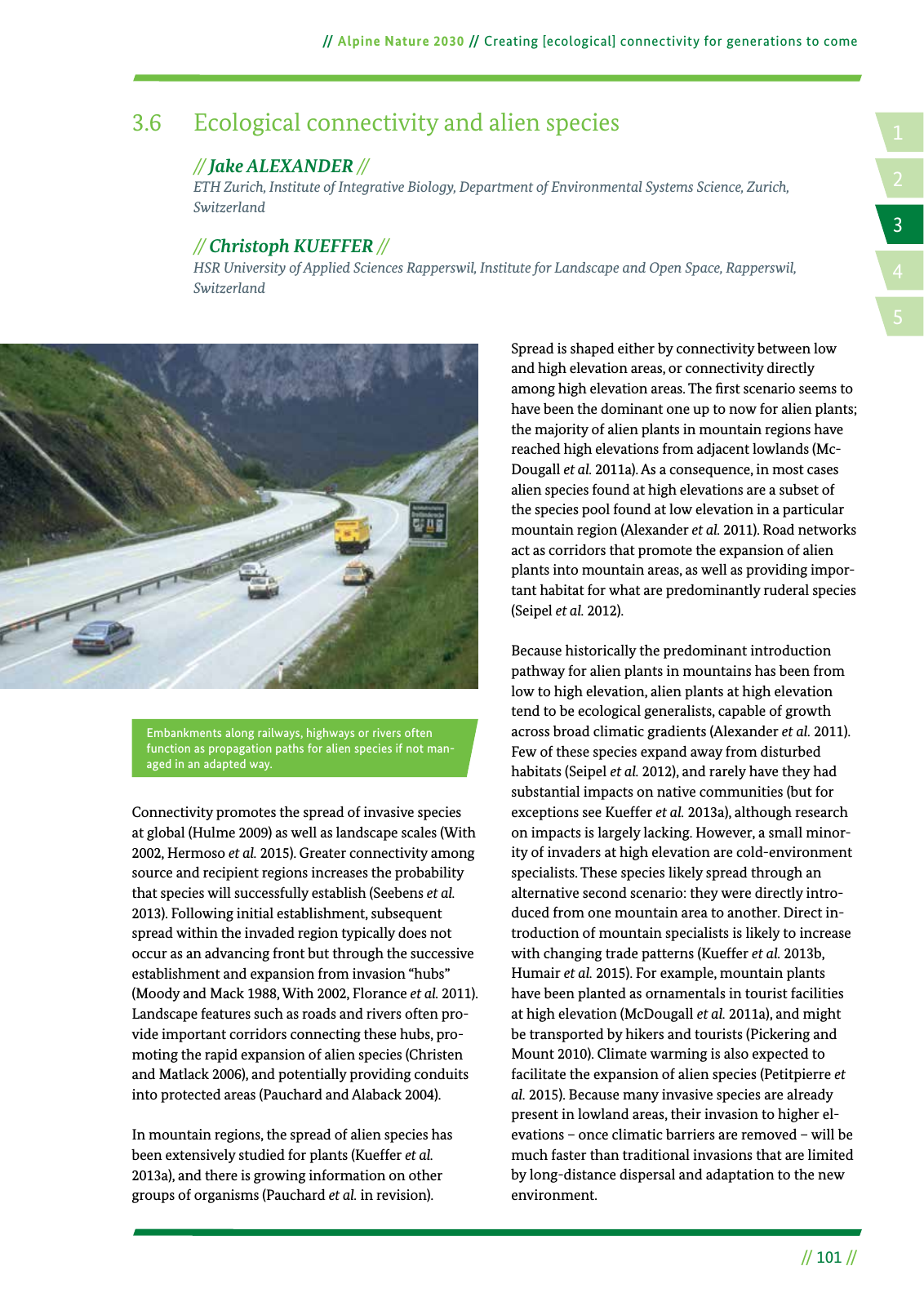14 2 5 3 Alpine Nature 2030 Creating ecological connectivity for generations to come 101 3 6 Ecological connectivity and alien species Jake ALEXANDER ETH Zurich Institute of Integrative Biology Department of Environmental Systems Science Zurich Switzerland Christoph KUEFFER HSR University of Applied Sciences Rapperswil Institute for Landscape and Open Space Rapperswil Switzerland Connectivity promotes the spread of invasive species at global Hulme 2009 as well as landscape scales With 2002 Hermoso et al 2015 Greater connectivity among source and recipient regions increases the probability that species will successfully establish Seebens et al 2013 Following initial establishment subsequent spread within the invaded region typically does not occur as an advancing front but through the successive establishment and expansion from invasion hubs Moody and Mack 1988 With 2002 Florance et al 2011 Landscape features such as roads and rivers often pro vide important corridors connecting these hubs pro moting the rapid expansion of alien species Christen and Matlack 2006 and potentially providing conduits into protected areas Pauchard and Alaback 2004 In mountain regions the spread of alien species has been extensively studied for plants Kueffer et al 2013a and there is growing information on other groups of organisms Pauchard et al in revision Spread is shaped either by connectivity between low and high elevation areas or connectivity directly among high elevation areas The rst scenario seems to have been the dominant one up to now for alien plants the majority of alien plants in mountain regions have reached high elevations from adjacent lowlands Mc Dougall et al 2011a As a consequence in most cases alien species found at high elevations are a subset of the species pool found at low elevation in a particular mountain region Alexander et al 2011 Road networks act as corridors that promote the expansion of alien plants into mountain areas as well as providing impor tant habitat for what are predominantly ruderal species Seipel et al 2012 Because historically the predominant introduction pathway for alien plants in mountains has been from low to high elevation alien plants at high elevation tend to be ecological generalists capable of growth across broad climatic gradients Alexander et al 2011 Few of these species expand away from disturbed habitats Seipel et al 2012 and rarely have they had substantial impacts on native communities but for exceptions see Kueffer et al 2013a although research on impacts is largely lacking However a small minor ity of invaders at high elevation are cold environment specialists These species likely spread through an alternative second scenario they were directly intro duced from one mountain area to another Direct in troduction of mountain specialists is likely to increase with changing trade patterns Kueffer et al 2013b Humair et al 2015 For example mountain plants have been planted as ornamentals in tourist facilities at high elevation McDougall et al 2011a and might be transported by hikers and tourists Pickering and Mount 2010 Climate warming is also expected to facilitate the expansion of alien species Petitpierre et al 2015 Because many invasive species are already present in lowland areas their invasion to higher el evations once climatic barriers are removed will be much faster than traditional invasions that are limited by long distance dispersal and adaptation to the new environment Embankments along railways highways or rivers often function as propagation paths for alien species if not man aged in an adapted way

Hinweis: Dies ist eine maschinenlesbare No-Flash Ansicht.
Klicken Sie hier um zur Online-Version zu gelangen.
Klicken Sie hier um zur Online-Version zu gelangen.